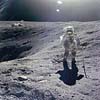 |
Paris, France (SPX) Sep 19, 2005 This image, taken by the Advanced Moon Micro-Imager Experiment (AMIE) on board ESA's SMART-1 spacecraft, shows the lunar Alps (Montes Alpes) on the Moon. AMIE obtained this image from a distance of about 3000 kilometres, with a resolution of 300 metres per pixel. The field of view of this image is about 150 kilometres and is centred on an area around 48.5� North, 3.2� East. The European Alps were formed over millions of years by slow-moving sections of Earth's crust pushed together, squeezing the land to form a giant arc of upthrust mountains, but the lunar Alps were formed in an instant. It is thought that the Moon collided with a huge object, such as an asteroid, 4000 million years ago. The collision formed a huge crater, about 1000 kilometres in diameter. This crater was later filled with basaltic lava, forming the dark circular basin known as Mare Imbrium (Sea of Rains). After the explosive collision, fragments, rocks and dust fell back to the surface, forming two concentric rings of mountains making up the crater rim. A flood of lava covered the lower inner one, but the outer one remains as a series of arc-shaped mountain ranges. In places these mountains rise over 3000 metres. Their inner walls are steep and well defined, but their outer slopes become more broken as elevation decreases away from the impact site. Early European astronomers named them after familiar mountain ranges, such as the Juras, the Apennines and the Alps. Seen in this image, Vallis Alpes (Alpine Valley) is a spectacular feature that bisects the Montes Alpes range. This valley was discovered in 1727 by Francesco Bianchini. It extends 166 kilometres from Mare Imbrium, trending north-east to the edge of the Mare Frigoris (Sea of Cold). The valley is narrow at both ends and widens to about 10 kilometres across. The valley floor is a flat, lava-flooded surface that has narrow sinous 'rille' running down the middle. The valley is believed to be a broad lava channel put in place during the formation of the maria, the rille corresponds to a 'lava tube' formed in a later geological episode by high-speed and low viscosity magma. "SMART-1 is studying the signature of violent processes that took place during the formation of these giant impact basins, as well as the sequence of late volcanic history over the lunar surface until 3000 million years ago," said ESA's SMART-1 Project Scientist Bernard Foing. Email This Article
Related Links  Washington (AFP) Sep 19, 2005
Washington (AFP) Sep 19, 2005The United States will send four astronauts to the moon in 2018 in a major return to its pioneering manned missions into space, NASA administrator Michael Griffin announced Monday. |
|
| The content herein, unless otherwise known to be public domain, are Copyright 1995-2006 - SpaceDaily.AFP and UPI Wire Stories are copyright Agence France-Presse and United Press International. ESA PortalReports are copyright European Space Agency. All NASA sourced material is public domain. Additionalcopyrights may apply in whole or part to other bona fide parties. Advertising does not imply endorsement,agreement or approval of any opinions, statements or information provided by SpaceDaily on any Web page published or hosted by SpaceDaily. Privacy Statement |